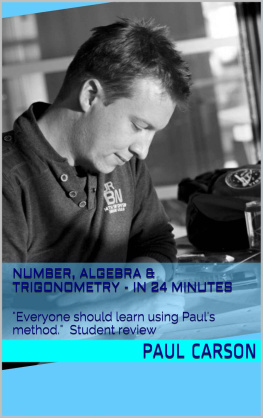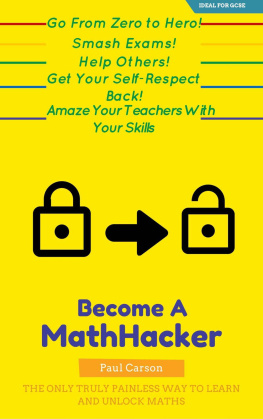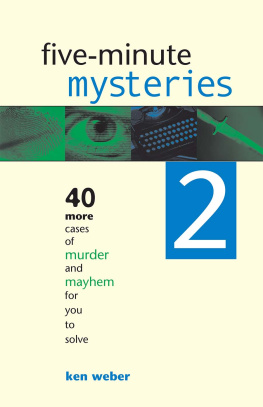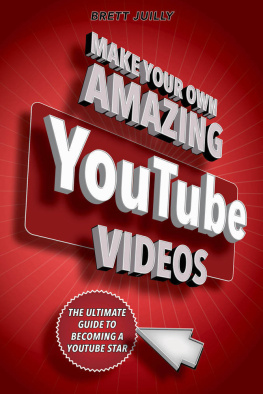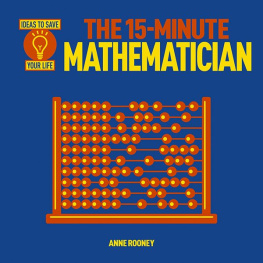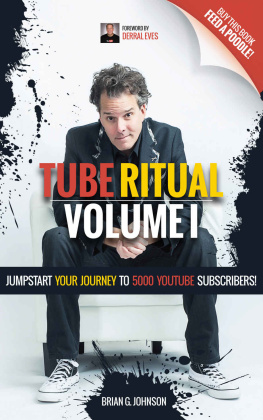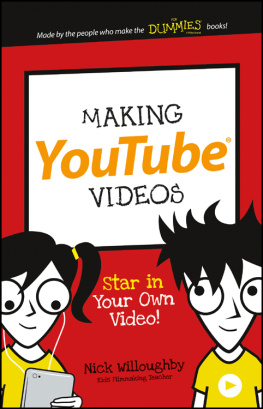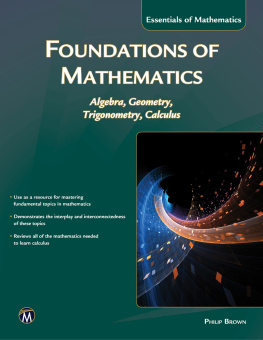Contents
Name/Copyright Number, Algebra & Trigonometry In 24 Minutes Paul Carson 2014 Dedication To Edyta, for inspiring me to start writing again. Blog http://mathsinaminute.blogspot.com Website http://www.paulcarsonmaths.co.uk Twitter @In_A_Min Email YouTube Channel Containing Instructional Videos http://www.youtube.com/user/InAMinMaths
Series Contents Series of books and titles Naked Numbers: The 3 Rules To Make Your Life Add Up , Hodder Education, the Michel Thomas Method (2010) Maths in a Minute Series Contents and numbering 2nd September 2013
- Multiplication
- Division
- Fractions
- Decimals
- Percentages
- Negative Numbers
- Squaring & Area
- Cubing & Volume
- Indices
- Standard Form
- Logarithms
- Sequences
- Gradient/Equation of A Straight Line
- Simultaneous Equations
- Quadratics
- Inequalities
- Changing the Subject
- Cubics
- Algebraic Fractions
- Algebra of Arithmetic
- Angles and Radians
- Gradient/Tangent
- Sine and Cosine
- Sine and Cosine Rules
- Pythagoras Theorem
- Gradient/Differentiation 1
- Integration 1
- Polynomials
- Types of Functions
- Co-ordinate Geometry
- Differentiation 2
- Integration 2
- Binomial Theorem
- Trigonometry
- Numerical Methods
- Differential Equations
- Mechanics
- Vectors
- Engineering Fundamentals
- Coding Fundamentals
- Statistics
- Matrices
- The Slide Rule
- Richard Feynman
- The Current Mathematics Teaching System
- How the MinAMin Method Works
- Complex Numbers
- Partial Differentiation
- Series
- Integration 3
- Multiple Integrals
- Differential Equations
- Fourier Series
- Partial Differential Equations
- Vector Calculus
Proverb Nil Satis Nisi Optimum (
Nothing but the best is good enough - Everton FC proverb)
Introduction to Multiplication Introduction
The idea of optimised mathematics. There are loads of multiplication techniques out there. Egyptian Babylonian Chinese Russian Napiers bones Grid method Long multiplication The list goes on. You could try each of these yourself and decide which is best. What I want you to do is optimise.
I want you to do this multiplication in the most efficient, intuitive and mathematically advantageous way. A method that allows you to do five other things. And a half. But Ill get to that. School teaches all sorts of ways with the hope that one will snag and youll be able to do it. The most popular is the grid method.
The requirements of optimised mathematics. To do maths easily, the method used must be
- Optimum
- Fast
- Little working
- Subliminal
- Mathematical
- Verifiable
We will discuss each of these in turn but first Why school techniques dont work Some of their methods work. Of course they do. But why do people struggle so? Because the methods require memorisation of a number of steps, which, if any are wrong, makes the answer incorrect. Worse, it is not possible to know yourself if it is incorrect. You have to ask someone else.
What kind of system is that? Is this right, Miss? Plus, because youre memorising steps, you dont really understand what is happening. And this leads to uncertainty. This means that youre being trained to act like a robot. And robots dont think for themselves. So how would you know if it was right or wrong? Only if your controller tells you so! It is vital, really vital, that we know why we are doing things. This makes it easy to remember, more interesting to learn, and allows creativity of thought.
And even improvements of existing systems. I shall use an analogy to illustrate. Do you have to remind yourself not to put your hand on a hot stove? No? Why not? Because you understand the consequences if you were to do so. You dont have to memorise a rule Never touch a hot stove and not understand why. You already understand why. And so it is easy to remember and impossible to forget! Recently, my curious cat decided to walk on my kitchen tops and over the cooker.
Unfortunately the stove plate was still hot as I had just used it. There would have been no point teaching him about this beforehand. But now he will never forget. I learnt maths in the same way...via painful failure! So you can avoid my mistakes from reading this course. Understanding why something is makes it easy to remember and impossible to forget. That is how anything should be learned.
And it works especially well with maths. Discussion on Requirements of a Maths Method OPTIMISATION. It needs to be easy, fast and efficient. It needs to be easy to remember too. FAST. The methods I teach here are fast. With fluency they take no longer than 5 seconds.
There will be an effectively instant answer, perhaps as quick (or quicker) than using a calculator. LITTLE WORKING. At school they are always banging on about showing your working. Fine. Unless its not necessary of course. My method has no working in it. So theres none to show! SUBLIMINAL. What I mean by this, is that the clever bit of my method is contained here.
Youre going to intuitively learn to do algebra, complex numbers and decimals (and a dollop of standard form) by learning this method. So Im subliminally teaching you advanced mathematics. Easily! MATHEMATICAL. The technique involves use of mathematical concepts which give you an intuitive feel of algebra and how it works. It stumbles on something called The Fundamental Theorem of Algebra, but I wont be mentioning that againtrust me. Adopting this method will make you become a natural mathematician, with none of the associated and inevitable geekiness. VERIFIABLE. The method also includes a way to CHECK your answer is correct, YOURSELF.
This means that you can know for certain that the answer is right. Plus it only takes a few seconds. Lets start. So in a book about multiplication, the first question has to be. What is multiplication? Before I just give you the answer, I want you to think about it a little bit. Like youve probably thought about the consequences of putting your hand on a hot stove, what you know, you wont forget.
And if you come up with it yourself, youll definitely remember it! So, to make it a little more challenging and point you in the right direction as well, think for a moment, what is multiplication? But in your answer, you cannot, CANNOT, use the words Multiply Times Product By Think about it. Think about it. A bit more. What have you got? Multiplication is.. Now in 13 years of tutoring, I have heard some varied answers. And Im not going to embarrass my students by referring to them here.
The overriding result, although not for everyone, isactually, I dont know. Isnt that something? 10 years in education (or more) and they dont know. Is that their fault, or schools? In my opinion it is schools. When I show you how easy this can be, you will be amazed that school can make it so hard. What Multiplication Is Chapter 1 What multiplication is So, what did you come up with? Heres the answer: Multiplication is just..repeated addition. (Is that what you came up with? If not, dont worry.) Lets look at this. (Is that what you came up with? If not, dont worry.) Lets look at this.
Multiplication of two numbers tends to be thought of as timesing two numbers together. The word times here, which has morphed into a verb over the years, actually refers to the number of times we add. This is very important. It is how many times we add. For example, 3 x 5 = 15 Because we add 5 3 times. So above, you probably read that as 3 times 5.
Now read it as 3 times (we add) 5. 3 x 5 = 3 times (we add) 5 = 5 + 5 + 5 = 15. Another example 4 x 6 = 4 times (we add) 6 = 6 + 6 + 6 + 6 = 24 And so on! 5 x 7 = 5 times (we add) 7 = 7 + 7 + 7 + 7 + 7 = 35 How exciting. This is how easy it is. Multiplication is just addition! So the times is not another word for multiply, it is actually the number of times we add. You can probably see that this is Victorian sort of language, which has got dropped over the years.

